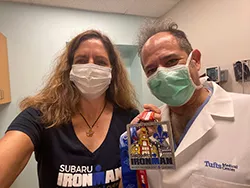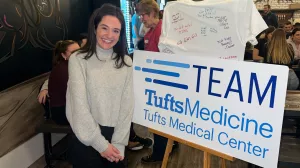
Sandy Neargarder needed a lifestyle change. The Professor of Psychology at Bridgewater State University was in her late 40s in 2015, was 60 pounds overweight and wasn't feeling healthy. As she prepared to begin a six-month sabbatical, Neargarder made it her goal to not only get in shape but to get in SUCH good shape that she could complete a triathlon. The decision may very well have saved her life.
Triathlons consist of a swim, a bike ride and a run of varying lengths. Neargarder had some biking experience, but she had never been a runner and didn't even know how to swim. She learned the best techniques for distance running first, then began swimming lessons at age 48.
"At first, I couldn't even put my head under water," said Neargarder. "It took me four months to swim half a length of the pool. But after a year of lessons, I could swim well enough to attempt my first triathlon."
Over the next seven years, Neargarder completed 12 sprint triathlons (.25-mile swim, 12-mile bike, 3.1-mile run), three Olympic triathlons (1.0-mile swim, 25-mile bike, 6.2-mile run) and four Half Ironman triathlons (1.2-mile swim, 56-mile bike, 13.1-mile run). But her ultimate goal was to finish a full Ironman triathlon (2.4-mile swim, 112-mile bike, 26.2-mile run)—which requires completion in less than 17 hours.
Neargarder hired coach Rich Hatch from Triumph Endurance Coaching in December 2017 to help plan out her training regimen, with an eye on a full Ironman in 2020. Unfortunately, the COVID-19 pandemic put an end to those hopes. Neargarder continued her training, now looking towards 2021. But over the course of her training, Neargarder noticed that at times she felt a little lightheaded.
"The feeling was infrequent and it was more annoying than anything," said Neargarder. "And given the intensity of my preparation, I really didn't give it a second thought."
In early April 2021, Neargarder received a call from the office of her primary care physician George Gagne, MD, reminding her about the yearly bloodwork she needed to get done and recommending she come in for a checkup as well. The bloodwork was normal, as was her physical exam, but in chatting with Dr. Gagne, Neargarder mentioned the lightheadedness. Dr. Gagne told her that the previous year he also experienced feelings of dizziness and was ultimately diagnosed with a brain aneurysm. He said he would order a brain CTA scan for Neargarder, out of an abundance of caution.
Five minutes after Neargarder returned home from her scan, the phone rang. It was Dr. Gagne.
"Sandy," he said. "You have a brain aneurysm."
Neargarder was in complete shock.
"I teach courses in neuropsychology—the brain is my specialty," said Neargarder. "I knew all about brain aneurysms. I just never expected it would happen to me."
Dr. Gagne recommended she make an appointment with a neurosurgeon immediately. Neargarder started doing research and consulting with doctors on brain aneurysm experts in the area. Finally, she settled on her preferred neurosurgeon: Adel Malek, MD, PhD, Chief of Neurovascular Surgery at Tufts Medical Center.
"I had doctors tell me, 'If I had a brain aneurysm, this is the guy I'd want operating on me,'" said Neargarder. "That gave me a lot of confidence that Dr. Malek was the right choice."
In less than a week, Neargarder had an appointment with Dr. Malek and discussed the possible options with him. The aneurysm was small, but size alone was not an accurate determinant of if and when it might burst. Other factors such as aneurysm location, type, shape and patient history were important to consider. Dr. Malek explained that immediate treatment for the aneurysm was necessary.
"Both heavy physical exertion and excessive stress on the body can increase the risk of aneurysm rupture," said Dr. Malek. "We always want to avoid getting to that point, as the risk of death is 20-30 percent if a brain aneurysm bursts."
Neargarder underwent additional testing to determine the best approach to treat the aneurysm. The two potential options included either performing surgical clipping of the aneurysm neck under the microscope, which requires going through the skull and has a longer recovery time, or a minimally invasive endovascular approach. This entailed using a miniature catheter, traveling through the femoral or radial artery under x-ray guidance to reach the aneurysm and block it from the inside. This endovascular approach can be performed using carefully sized platinum coils or mesh webs from the inside to fill the aneurysm, and possibly using stents, to ensure secure placement. If she required a stent, Neargarder would need to go on blood thinners, which could substantially affect her training. Not surprisingly, she strongly favored the less invasive option. Dr. Malek would not know for sure if stents were required until he performed the surgery.
"We were fortunate that the aneurysm was small enough and was in an accessible location, which made it an ideal candidate for a 3D framing coil approach, with no stents needed," said Dr. Malek. "This procedure did not require open surgery or long-term blood thinners, and was an optimal option for someone with Sandy's lifestyle and athletic ambitions."
Dr. Malek performed the surgery in May 2021, about three weeks after the initial diagnosis. It took Neargarder just one week to recover and she was back to her training. Unfortunately, a subsequent Lyme disease diagnosis, followed by a case of COVID-19, set Neargarder too far back in her training to attempt the Ironman in 2021.
By the time 2022 rolled around, Neargarder was more determined than ever to finally achieve her goal of completing a full Ironman. Now fully recovered from her illnesses, she began her training on February 1st, and over the next six-and-a-half months, traveled 3,310 miles (more than 300 miles further than the distance between Boston and Los Angeles) between swimming, biking and running. In August 2022, Neargarder reached her goal and completed a full Ironman in Canada in a time of 13:38:25.
"It was a big weight lifted off my shoulders," said Neargarder. "I've been through so much and worked so hard towards this goal, that finally being able to accomplish it was incredibly satisfying."
And now a year-and-a-half post-procedure, the news on her brain aneurysm is great as well.
"Her prognosis is excellent," said Dr. Malek. "Sandy has had two MRIs since her surgery and the aneurysm has remained well-blocked over time. She needs to be seen once per year at this point and it's likely we will eventually be able to transition to once every three years."
"I'm very lucky that my brain aneurysm was caught early and addressed quickly," said Neargarder. "I can continue to live my life and reach my goals and I'm extremely grateful for that."
